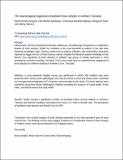| dc.contributor.author | Sungura, Richard Erasto | |
| dc.contributor.author | Spitsbergen, John Martin | |
| dc.contributor.author | Mpolya, Emmanuel | |
| dc.contributor.author | Sauli, Elingarami | |
| dc.contributor.author | Vianney, John-Mary | |
| dc.date.accessioned | 2020-06-03T08:49:38Z | |
| dc.date.available | 2020-06-03T08:49:38Z | |
| dc.date.issued | 2020-05-21 | |
| dc.identifier.uri | https://doi.org/10.11604/pamj.2020.36.25.22515 | |
| dc.identifier.uri | https://dspace.nm-aist.ac.tz/handle/20.500.12479/765 | |
| dc.description | This research article published by The Pan African Medical Journal, 2020 | en_US |
| dc.description.abstract | Introduction: the loss of parenchymal brain volume per normative age comparison is a distinctive feature of brain atrophy. While the condition is the most prevalent to elderly, it has also been observed in pediatric ages. Various causes such as trauma, infection, and malnutrition have been reported to trigger the loss of brain tissues volume. Despite this literature based knowledge of risk factors, the magnitude of brain atrophy in pediatric age group is scantly addressed in most developing countries including Tanzania. The current study aims to understand the magnitude of brain atrophy in children residing in Northern Zone, Tanzania.
Methods: a cross-sectional hospital survey was performed in which 455 children who were presented with various brain pathologies from the year 2013 to 2019 and whose brains examined by Computerized tomography (CT)-Scanners were recruited in the study. The brain statuses were examined using three linear radiological methods including the measure of sulcal-width, Evans index, and lateral ventricular body width.
Results: results showed a significant number of atrophied brains among children in Northern Tanzania and that the condition was observed to have a 1:1 male to female ratio. The prevalence of pediatric brain atrophy was found to be 16.04%.
Conclusion: the cortical subtype of brain atrophy presented as the most prevalent type of brain volume loss. The findings of this study suggest existence of considerable trends of brain atrophy in children which need special attention and mitigation plans. | en_US |
| dc.language.iso | en | en_US |
| dc.publisher | The Pan African Medical Journal | en_US |
| dc.subject | Brain atrophy | en_US |
| dc.subject | Brain volume | en_US |
| dc.subject | Evans index | en_US |
| dc.title | The neuroimaging magnitude of pediatric brain atrophy in northern Tanzania | en_US |
| dc.type | Article | en_US |

